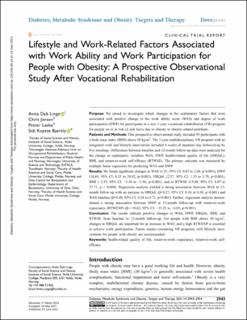| dc.description.abstract | Purpose: We aimed to investigate which changes in the explanatory factors that were associated with positive change in the work ability score (WAS) and degree of work participation (DWP) for participants in a new 1-year vocational rehabilitation (VR) program for people on or at risk of sick leave due to obesity or obesity-related problems.
Patients and Methods: This prospective observational study included 95 participants with a body mass index (BMI) above 30 kg/m2. The 1-year multidisciplinary VR program with an integrated work and lifestyle intervention included 4 weeks of inpatient stay followed-up by five meetings. Differences between baseline and 12-month follow-up data were analyzed for the change in explanatory variables WAS, DWP, health-related quality of life (HRQoL), BMI, and return-to-work self-efficacy (RTWSE). The primary outcome was measured by multiple linear regression for predicting WAS and DWP.
Results: We found significant changes in WAS (1.51, 95% CI: 0.83 to 2.20, p< 0.001), DWP (18.69, 95% CI: 8.35 to 29.02, p< 0.001), HRQoL (2.57, 95% CI: 1.35 to 3.79, p< 0.001), BMI (− 2.33, 95% CI: − 3.10 to − 1.56, p< 0.001), and in RTWSE (15.89, 95% CI: 4.07 to 27.71, p = 0.009). Regression analysis yielded a strong association between WAS at 12-month follow-up with an increase in HRQoL (β=0.27, 95% CI: 0.16 to 0.38, p< 0.001) and WAS baseline (β=0.49, 95% CI: 0.28 to 0.71, p< 0.001). Further, regression analysis demonstrated a strong association between DWP at 12-month follow-up with return-to-work expectancy (RTWEXP) (β=− 10.62, 95% CI: − 15.25 to − 6.03, p< 0.001).
Conclusion: The results indicate positive changes in WAS, DWP, HRQoL, BMI, and RTWSE from baseline to 12-month follow-up. For people with BMI above 30 kg/m2, changes in HRQoL are important for an increase in WAS, and a high RTWEXP is essential to achieve work participation. Future studies examining VR programs with lifestyle interventions for people with obesity are recommended. | en_US |

